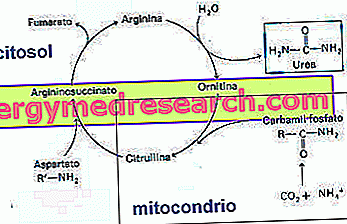Proteins ingested with food are hydrolyzed in the stomach and small intestine to produce free amino acids and oligopeptides. These products are absorbed by the cells of the small intestine and poured back into the bloodstream; most of the amino acids are therefore used by the various organs and tissues for cell renewal processes (protein turnover).
DEGRADATION OF AMINO ACIDS
Amino acids undergo degradation:
1) for normal protein turnover
2) when their dietary intake is excessive
3) in lack of carbohydrates
The first stage of amino acid catabolism involves the removal of the amino group. The carbon skeleton is thus used in the Krebs cycle or in gluconeogenesis.
Aminotransferases or transaminases represent the key enzymes in the removal of the amino group of amino acids.
Transamination reactions consist of the transfer of an amino group from a donor amino acid to alpha-ketoglutarate to form glutamate. During this reaction the donor amino group is converted into α- keto acid. Glutamate conveys amino groups towards the urea cycle or towards the biosynthetic pathways of amino acids.
The co-enzyme of transaminases is pyridoxal phosphate, an enzyme produced from pyridoxine (Vitamin B6).
Transaminations are reversible and can work in both directions, depending on the needs of the cell.
NITROGEN EXPRESSION
Usually the excess amino groups are excreted or used to synthesize nitrogen compounds.
An important process that amino acids encounter is oxidative deamination. It occurs in the mitochondria and is catalyzed by glutamate dehydrogenase, an enzyme that removes the amino group from glutamate and replaces it with oxygen from the water.
The ammonium ion that is formed reacts with glutamate to form glutamine, which acts as a transporter of amino groups to the liver. The enzyme that allows this ATP-dependent reaction is glutamine synthetase.
Glutamine enters the bloodstream and reaches the liver where, inside the hepatic mitochondria, it is converted back to glutamate with release of the NH4 + ammonium ion.
Alanine is the main transporter of amino groups from muscle to liver. It is formed by transfer of the amino group from glutamate to pyruvic acid or pyruvate. Similar to what happens for glutamine, once inside the hepatic mitochondria, alanine releases its own ammonium ion generating glutamate and pyruvate. Pyruvate is needed in the liver in the process called gluconeogenesis.
The NH4 + ammonium ion is toxic to the body's cells and in particular to the brain. As we have seen, in extrahepatic cases the ammonium ion is neutralized through the bond with glutamate or with pyruvate. In the liver, NH4 + is incorporated into the non-toxic urea molecule. Urea produced by the liver is transported through the blood to the kidneys for urinary excretion.
THE UREA CYCLE
The urea cycle begins with the formation of carbamyl phosphate by the enzyme carbamyl phosphate synthase. During this reaction two molecules of ATP are spent.
The subsequent reactions of the urea cycle are shown in the figure.

The urea cycle requires a high amount of energy (4 ATP for each urea molecule produced).
CATABOLISM OF THE CARBONIAN SKELETON OF AMINO ACIDS
The carbon skeleton of amino acids is used in the Krebs cycle to produce energy.

As shown in the figure the carbonaceous skeletons converge into seven compounds able to enter directly or indirectly in the Krebs cycle: pyruvate, acetylCoA, acetoacetylCoA, α-ketoglutarate, succinylCoA, fumarate, oxalacetate.
The amino acids that are degraded to acetylCoA or acetoacetylCoA are called ketogenetics and are the precursors of ketone bodies.
The others are glucogenic and can, once converted into pyruvate and oxalacetate, form glucose through gluconeogenesis.
See also: Amino acids, a look at chemistry
Protein, a look at chemistry



